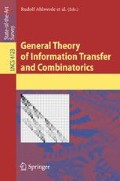Abstract
In earlier papers we introduced the measures of pseudorandomness of finite binary sequences [13], introduced the notion of f–complexity of families of binary sequences, constructed large families of binary sequences with strong PR (= pseudorandom) properties [6], [12], and we showed that one of the earlier constructions can be modified to obtain families with high f–complexity [4]. In another paper [14] we extended the study of pseudorandomness from binary sequences to sequences on k symbols (“letters”). In [14] we also constructed one “good” pseudorandom sequence of a given length on k symbols. However, in the applications we need not only a few good sequences but large families of them, and in certain applications (cryptography) the complexity of the family of these sequences is more important than its size. In this paper our goal is to construct “many” “good” PR sequences on k symbols, to extend the notion of f–complexity to the k symbol case and to study this extended f–complexity concept.
Access this chapter
Tax calculation will be finalised at checkout
Purchases are for personal use only
Preview
Unable to display preview. Download preview PDF.
References
Ahlswede, R.: Coloring hypergraphs: A new approach to multi–user source coding, Part I. J. Combinatorics, Information and System Sciences 4(1), 76–115 (1979); Part II, J. Combinatorics, Information and System Sciences 5(3), 220–268 (1980)
Ahlswede, R.: On concepts of performance parameters for channels. In: Ahlswede, R., Bäumer, L., Cai, N., Aydinian, H., Blinovsky, V., Deppe, C., Mashurian, H. (eds.) General Theory of Information Transfer and Combinatorics. LNCS, vol. 4123, pp. 639–663. Springer, Heidelberg (2006)
Ahlswede, R., Winter, A.: Strong converse for identification via quantum channels. IEEE Trans. on Inform. 48(3), 569–579 (2002)
Ahlswede, R., Khachatrian, L.H., Mauduit, C., Sárközy, A.: A complexity measure for families of binary sequences. Periodica Math. Hungar. 46(2), 107–118 (2003)
Cassaigne, J., Mauduit, C., Sárközy, A.: On finite pseudorandom binary sequences VII: The measures of pseudorandomness. Acta Arith. 103, 97–118 (2002)
Goubin, L., Mauduit, C., Sárközy, A.: Construction of large families of pseudo–random binary sequences. J. Number Theory 106, 56–69 (2004)
Halberstam, H., Richert, H.-E.: Sieve Methods. Academic Press, London (1974)
Heath–Brown, D.R.: Artin’s conjecture for primitive roots. Quat. J. Math. 37, 27–38 (1986)
Hooley, C.: On Artin’s conjecture. J. reine angew. Math. 225, 209–220 (1967)
Kohayakawa, Y., Mauduit, C., Moreira, C.G., Rödl, V.: Measures of pseudorandomness for random sequences. In: Proceedings of WORDS 2003, pp. 159–169. TUCS Gen. Publ., 27, Turku Cent. Comput. Sci., Turku (2003)
Lidl, R., Niederreiter, H.: Introduction to Finite Fields and Their Applications, revised edn. Cambridge University Press, Cambridge (1994)
Mauduit, C., Rivat, J., Sárközy, A.: Construction of pseudorandom binary sequences using additive characters. Monatshefte Math. 141, 197–208 (2004)
Mauduit, C., Sárközy, A.: On finite pseudorandom binary sequences, I. Measure of pseudorandomness, the Legendre symbol, Acta Arith. 82, 365–377 (1997)
Mauduit, C., Sárközy, A.: On finite pseudorandom sequences of k symbols. Indag. Math. 13, 89–101 (2002)
Schinzel, A.: Remarks on the paper Sur certaines hypothèses concernant les nombres premiers. Acta Arith. 7, 1–8 (1961/1962)
Schinzel, A., Sierpiński, W.: Sur certaines hypothèses concernant les nombres premiers. Ibid 4, 185–208 (1958); Corrigendum ibid 5, 259 (1959)
Weil, A.: Sur les courbes algébriques et les variétés qui s’en déduisent. Act. Sci. Ind. 1041, Hermann, Paris (1948)
Author information
Authors and Affiliations
Editor information
Editors and Affiliations
Rights and permissions
Copyright information
© 2006 Springer-Verlag Berlin Heidelberg
About this chapter
Cite this chapter
Ahlswede, R., Mauduit, C., Sárközy, A. (2006). Large Families of Pseudorandom Sequences of k Symbols and Their Complexity – Part I. In: Ahlswede, R., et al. General Theory of Information Transfer and Combinatorics. Lecture Notes in Computer Science, vol 4123. Springer, Berlin, Heidelberg. https://doi.org/10.1007/11889342_16
Download citation
DOI: https://doi.org/10.1007/11889342_16
Publisher Name: Springer, Berlin, Heidelberg
Print ISBN: 978-3-540-46244-6
Online ISBN: 978-3-540-46245-3
eBook Packages: Computer ScienceComputer Science (R0)

